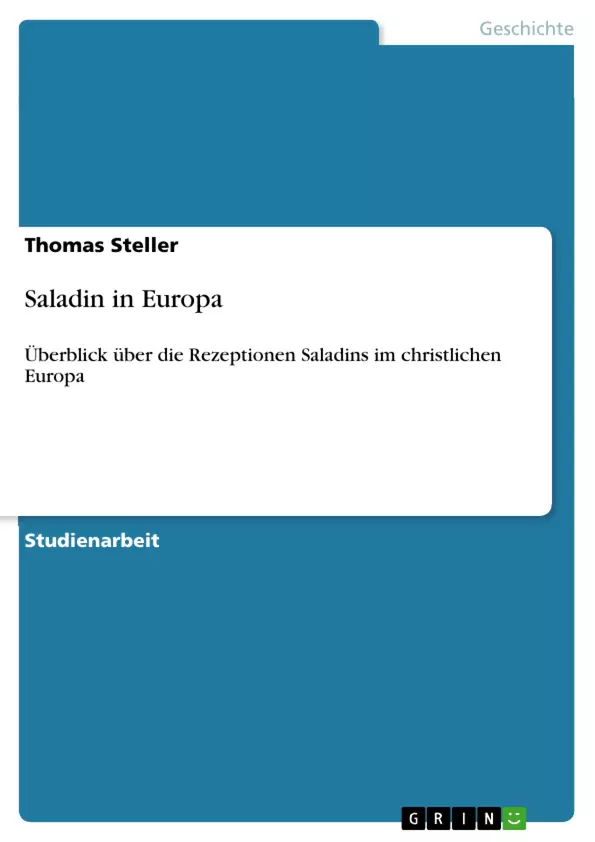This paper deals with the question in which way Sultan Saladin was perceived by the western world. For a long time his person has sparked a great number of fictional stories dealing with his life. Remarkably he was perceived quite paradoxically in two distinct ways.
Due to the strong Christian perception of history as path to salvation and the Influence of Augustine´s division of the world in civitas dei and civitas diaboli, the early accounts of his life are quite negative. As a usurper of power he is seen as salahdinus tyrannus. Quite a number of negative images were constructed in order to integrate him in this universalistic worldview. These propagandistic depictions surface immediately after the first contact of Crusaders and Saladin. This reception started at the end of the 12th and lasted until the end of the 13th century. They form as reaction to the catastrophic defeats which the Christians suffer. They are a way to overcome the shock and integrate these defeats in their teleological worldview so that may seem sensible.
A second group of more positive views of Saladin emerged in the 13th until the 15th century. They express a more distanced mentality towards these catastrophic events during the third crusade. Saladins transforms into the ideal noble Knight which exemplifies christian virtues. Again in the medieval historiography and literature the writers tried to integrate Saladin in their worldview.
He stands out in contrast to the very negative and dark images of Islam which are common in Europe in this time. In order to make his good deeds plausible stories about him being a knight or even of christian birth were invented. As in the first group he becomes a western instrument of criticism and propaganda though now in an opposite way. He is merely a reflex of western fears and problems than in any way close to the historic Person. Both groups show the same need to cope with Saladin. He posed a challenge to western Christian moral and religious belief-system. That’s why he had to be integrated in a positive or negative way. Afterwards a short sketch of Saladin in the Enlightenment and romantic tradition has been given. In his still ongoing reception Saladin has become a more and more flexible, adaptable symbolic figure which was used in diverse contexts to convey quite different messages. Only the scientific research of the 20th century has tried to portrait an objective picture of Saladin.
Inhaltsverzeichnis
- I. EINLEITUNG
- II. HAUPTTEIL
- II.1 KONTEXT KREUZZÜGE UND DAS LEBEN SALADINS
- II.2 SAGEN UM SALADIN IM CHRISTLICHEN EUROPA
- II.2.1 GRUNDSTRUKTUREN DER SAGEN
- II.2.2 GRUPPE I – NEGATIVE DARSTELLUNGEN
- II.2.3 GRUPPE II – POSITIVE DARSTELLUNGEN
- II.2.4 GRUPPE III - SALADIN IN DER LITERARISCHEN REZEPTION DER NEUZEIT
- III. RESUMÉE
- IV. ABSTRACT
- V. ANHANG ZEITTAFEL: SALADIN UND DIE KREUZZÜGE
- VI. LITERATURVERZEICHNIS
Zielsetzung und Themenschwerpunkte
Diese Arbeit bietet einen Überblick über die vielfältigen Rezeptionen der Figur Saladins im christlichen Europa. Sie untersucht, warum und wie Saladin im Westen wahrgenommen wurde und beleuchtet die Motive hinter den unterschiedlichen Darstellungen seiner Person. Der Fokus liegt auf der Analyse der Saladin-Sagen und ihrer Bedeutung als Spiegel der westlichen Kultur und Mentalität im Mittelalter.
- Die Entwicklung der Saladin-Sagen im europäischen Kontext
- Die unterschiedlichen Darstellungen Saladins in der Literatur und mündlichen Überlieferung
- Die Interpretation der Saladin-Sagen als Spiegelbild der europäischen Kultur und Mentalität
- Die Kontrastierung der verschiedenen Rezeptionen Saladins mit den historischen Fakten
- Die Analyse der Motive für die unterschiedlichen Darstellungen Saladins
Zusammenfassung der Kapitel
- Die Einleitung führt in die Thematik ein und stellt die Rezeption Saladins im christlichen Europa in den historischen Kontext. Sie skizziert die Bedeutung Saladins in der mittelalterlichen Literatur und erläutert die unterschiedlichen Rezeptionswege seiner Figur im Osten und Westen.
- Der Hauptteil beleuchtet die Sagen um Saladin im christlichen Europa. Er analysiert die Grundstrukturen dieser Sagen, unterscheidet zwischen negativen und positiven Darstellungen und untersucht die Rezeption Saladins in der Literatur der Neuzeit.
Schlüsselwörter
Saladin, Kreuzzüge, Mittelalter, Rezeption, europäische Kultur, Sagen, Legende, Mythos, Literatur, Geschichte, Mentalität, Kontextanalyse, historische Figur.
- Quote paper
- M.A. Thomas Steller (Author), 2007, Saladin in Europa, Munich, GRIN Verlag, https://www.grin.com/document/164053



